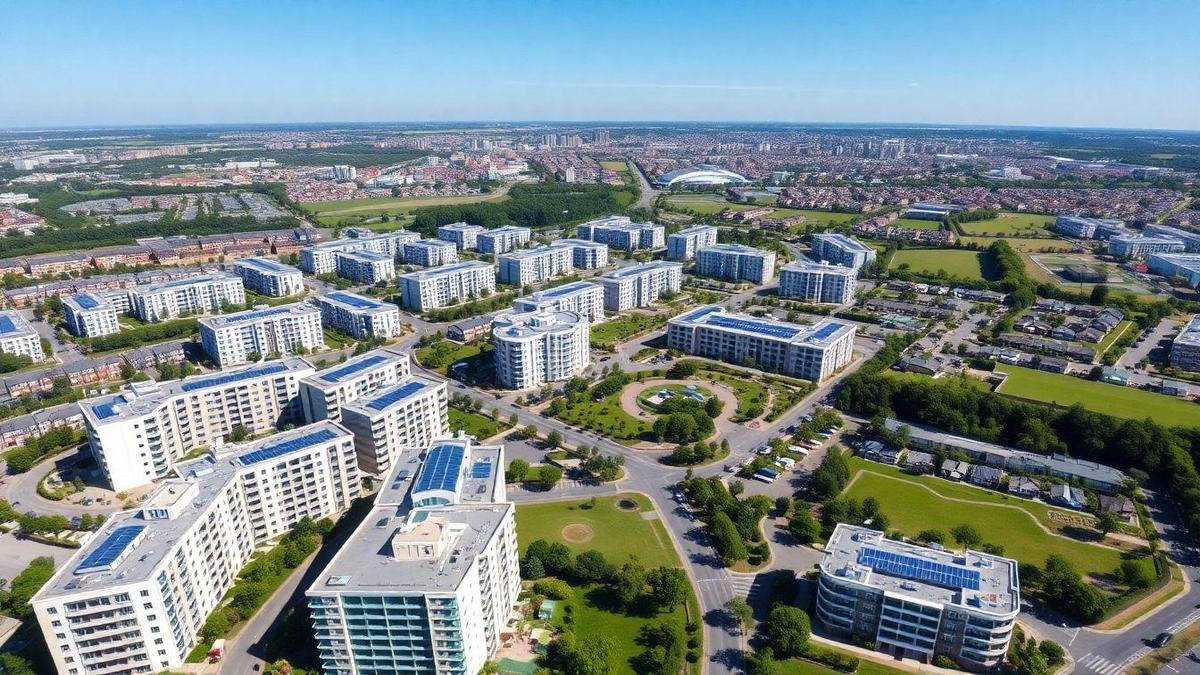Exploring the raw land investment strategy opens up a world of opportunities for savvy investors. This article guides readers through the basics of investing in raw land, highlighting its benefits and the key factors to consider. With a focus on smart growth, sustainable practices, and zoning regulations, the discussion covers how these elements shape property values and influence investment success. By the end, readers will grasp essential tips for navigating this unique investment landscape.
Main Points
- Raw land can be a smart investment choice.
- Research the area for growth potential.
- Understand zoning laws before purchasing.
- Keep future development in mind when buying.
- Patience is key for land investment success.

Understanding Raw Land Investment Strategy
What is Raw Land Investment?
Raw land investment refers to the practice of purchasing undeveloped land with the intention of holding it for future use or development. Investors typically see this as a way to capitalize on the potential increase in land value over time. Unlike other real estate investments, raw land does not come with buildings or existing infrastructure, making it a blank canvas for future projects. This investment strategy can be appealing for those looking to diversify their portfolios or enter the real estate market without the complexities of managing properties.
Benefits of Investing in Raw Land
Investing in raw land offers several benefits that can make it an attractive option for investors:
- Low Maintenance: Raw land generally requires less upkeep compared to developed properties, reducing ongoing costs.
- Potential for High Returns: As urban areas expand, the value of raw land can increase significantly, leading to potential profits.
- Flexibility: Investors have the freedom to develop the land as they see fit, whether for residential, commercial, or agricultural purposes.
- Tax Benefits: In some cases, raw land can offer tax advantages, such as deductions for property taxes.

The Role of Smart Growth Strategies
Defining Smart Growth in Land Development
Smart growth is a planning approach that promotes sustainable land use and development. It focuses on creating vibrant communities that are economically strong and environmentally friendly. This strategy encourages mixed-use development, where residential, commercial, and recreational spaces coexist. By prioritizing public transportation, walkability, and green spaces, smart growth aims to enhance the quality of life for residents.
How Smart Growth Affects Property Value
Smart growth can significantly impact property values. Properties in well-planned areas tend to appreciate more over time. Here are some key factors:
| Factor | Impact on Property Value |
|---|---|
| Proximity to Amenities | Increases desirability |
| Public Transportation Access | Enhances accessibility |
| Green Spaces | Improves community appeal |
| Mixed-Use Developments | Attracts diverse populations |
Investors should pay attention to these factors as they can lead to higher returns on their investments. Areas that implement smart growth strategies often see a boost in demand, which translates to increased property values.
Implementing Smart Growth Principles in Investments
For investors looking to adopt a raw land investment strategy, implementing smart growth principles is essential. Here are some steps to consider:
- Research Local Plans: Understand the community’s growth plans and zoning regulations.
- Engage with Stakeholders: Collaborate with local governments, planners, and community members.
- Prioritize Sustainability: Invest in projects that promote environmental health and community well-being.
- Focus on Accessibility: Choose locations that offer easy access to transportation and amenities.
By following these principles, investors can make informed decisions that align with smart growth strategies, ultimately leading to successful investments.

Essential Land Investment Tips for Success
Researching Land Before Purchase
Before diving into a raw land investment strategy, one must conduct thorough research. This step is crucial to avoid potential pitfalls. Investors should start by gathering information about the land’s zoning laws, environmental restrictions, and land use regulations.
A good practice is to check local government websites or consult with real estate professionals. They can provide insights into the land’s history, including any previous sales, disputes, or issues that may affect its value.
Evaluating Location and Accessibility
Location is often the cornerstone of any successful land investment. Investors should consider the following factors:
- Proximity to amenities: Is the land near schools, shopping centers, or hospitals?
- Transport links: Are there major roads or public transport options nearby?
- Future developments: Are there any planned projects that could increase the land’s value?
| Factor | Importance Level |
|---|---|
| Proximity to amenities | High |
| Transport links | High |
| Future developments | Medium |
Understanding these aspects can lead to better investment decisions. A piece of land in a growing area can appreciate quickly, while land in a declining area may not yield a good return.
Common Mistakes to Avoid in Land Investment
Investors often make mistakes that can cost them dearly. Here are some common pitfalls to watch out for:
- Ignoring due diligence: Failing to research the land thoroughly can lead to unexpected issues. For more insights, consider the top mistakes in land development.
- Overlooking hidden costs: Taxes, maintenance, and development fees can add up quickly.
- Rushing the decision: Taking time to evaluate all options is essential. Quick decisions can lead to regret.
Investors should keep these mistakes in mind to navigate the complexities of land investment successfully.

Sustainable Land Development Practices
Importance of Sustainability in Land Use
Sustainability is key in land use today. It means using land in a way that meets the needs of the present without harming future generations. This approach helps protect the environment, supports local communities, and boosts the economy. By focusing on sustainable practices, investors can create a positive impact while also increasing the value of their investments.
Examples of Sustainable Land Development
There are many ways to practice sustainable land development. Here are a few examples:
| Practice | Description |
|---|---|
| Green Building | Using eco-friendly materials and designs for buildings. |
| Community Gardens | Creating spaces for local food production and community bonding. |
| Renewable Energy | Incorporating solar panels or wind turbines in developments. |
| Water Conservation | Implementing systems to recycle water and reduce usage. |
These methods not only benefit the environment but also attract buyers and renters who care about sustainability.
Long-term Benefits of Sustainable Practices
Investing in sustainable land development has long-term benefits:
- Higher Property Values: Sustainable properties often sell for more due to their eco-friendly features.
- Lower Operating Costs: Energy-efficient buildings save money on utilities.
- Community Support: Sustainable projects can lead to stronger community ties, making them more appealing to residents.
In essence, sustainable land development is a smart choice for investors looking to make a lasting impact while also reaping financial rewards.

Navigating Zoning Regulations
Understanding Zoning Laws and Their Impact
Zoning laws are the rules that govern how land can be used. They affect everything from residential homes to commercial buildings. For global investors, understanding these laws is crucial. They can dictate what type of development can occur on a piece of land, which directly impacts the raw land investment strategy.
For instance, if an investor buys land in an area zoned for residential use, they may not be able to build a shopping center. This can limit potential returns on their investment. Local governments set these laws to manage growth and ensure safety in communities.
How to Work with Local Zoning Boards
Working with local zoning boards is essential for any investor. These boards are responsible for enforcing zoning laws and reviewing development proposals. Here are some steps to effectively engage with them:
- Research Local Regulations: Before making any investment, familiarize yourself with the zoning laws in the area.
- Attend Zoning Meetings: These meetings are open to the public. Attending them allows investors to understand community concerns and board expectations.
- Build Relationships: Establishing a rapport with board members can make the process smoother. They can provide insights that may not be publicly available.
- Prepare a Solid Proposal: When presenting a development plan, it should align with community needs and zoning regulations. This increases the chances of approval.
Zoning Changes and Investment Opportunities
Zoning changes can create new investment opportunities. When a local government decides to rezone an area, it can increase the land’s value significantly. For example, if a piece of land is rezoned from agricultural to commercial, its potential uses expand, attracting more investors.
Here’s a quick table to illustrate how zoning changes can impact land value:
| Zoning Type | Potential Uses | Value Increase Potential |
|---|---|---|
| Agricultural | Farming, Ranching | Low |
| Residential | Homes, Apartments | Medium |
| Commercial | Retail, Offices | High |
| Mixed-Use | Combination of All | Very High |
Investors should keep an eye on local government agendas for potential zoning changes. By staying informed, they can act quickly to capitalize on new opportunities.

Property Value Appreciation in Raw Land
Factors That Influence Land Value
Understanding what drives land value is crucial for any investor. Several key factors come into play:
- Location: Land in urban areas or near amenities typically fetches a higher price. For example, a plot near a growing city can appreciate faster than one in a remote area.
- Zoning Regulations: The type of zoning affects what can be built on the land. Residential, commercial, or agricultural zoning can influence its worth.
- Access to Utilities: Land with easy access to water, electricity, and sewage systems is more valuable. Investors should look for land that is “ready to build.”
- Market Demand: A high demand for land in a specific area can drive prices up. Keeping an eye on local trends can provide insights into potential appreciation.
Timing the Market for Maximum Returns
Timing can make or break an investment. Knowing when to buy or sell is essential. Here are some tips:
- Market Trends: Tracking local real estate trends helps investors identify the right moment to make a move.
- Economic Indicators: Pay attention to interest rates and employment rates. A strong economy often leads to increased land values.
- Seasonality: Certain times of the year may be better for buying or selling. For instance, spring and summer often see more activity in the real estate market.
Strategies for Enhancing Property Value
Investors can take several steps to boost the value of their raw land. Here are some effective strategies:
- Improving Accessibility: Adding roads or pathways can make land more attractive.
- Clearing the Land: Removing debris or old structures opens up possibilities for new development.
- Land Development Plans: Having a vision for what can be built can enhance value. Investors should consider creating plans that appeal to buyers.
- Environmental Assessments: Conducting studies can reveal the land’s potential and highlight any issues that need addressing.
| Strategy | Description | Expected Outcome |
|---|---|---|
| Improving Accessibility | Adding roads or pathways | Increased attractiveness |
| Clearing the Land | Removing debris or old structures | Opens up development options |
| Land Development Plans | Creating appealing development plans | Higher buyer interest |
| Environmental Assessments | Identifying potential and issues | More informed decisions |

Current Investment Land Trends
Emerging Markets in Raw Land Investment
In today’s economic landscape, raw land investment is gaining traction. Investors are increasingly looking towards emerging markets. Countries in Southeast Asia, Africa, and parts of South America are becoming hotspots. These regions offer affordable land prices and potential for high returns. For instance, a recent study showed that land in parts of Vietnam has appreciated by over 30% in just a few years.
Investors are drawn to these areas for several reasons:
- Lower Entry Costs: This allows investors to enter the market without breaking the bank.
- Growth Potential: Many of these markets are developing quickly, creating opportunities for profit.
- Diverse Opportunities: From agriculture to tourism, the possibilities are vast.
Technology’s Impact on Land Investment Trends
Technology is reshaping how investors approach land. Geographic Information Systems (GIS) and drones are tools that provide crucial data. This technology helps investors assess land value and potential uses more effectively.
For example, using GIS, an investor can analyze soil quality, water access, and zoning laws before making a purchase. This data-driven approach minimizes risks and maximizes returns.
Moreover, online platforms have made it easier for investors to connect with sellers globally. They can browse listings, compare prices, and even conduct virtual tours of properties. This digital shift has opened new doors for investors, making land investment more accessible than ever.
Future Predictions for Land Investment
Looking ahead, the land investment landscape is expected to evolve. With increasing urbanization and population growth, demand for land will rise. Investors should keep an eye on these trends:
| Trend | Description |
|---|---|
| Sustainability | More buyers will seek eco-friendly land options. |
| Urban Expansion | Cities will continue to grow, increasing land value. |
| Remote Work | Demand for residential land in rural areas will surge. |
As cities expand and technology advances, the raw land investment strategy will remain vital. Investors who adapt to these changes are likely to thrive.

Growth Management Strategies for Investors
Balancing Development and Environmental Concerns
Investors often face the challenge of balancing growth with environmental protection. It is crucial to develop land while also caring for the surroundings. Investors can adopt strategies that promote sustainable practices. For instance, they can use green building methods and preserve natural habitats. This approach not only benefits the environment but also enhances property values.
Here are some key strategies investors may consider:
- Conduct Environmental Assessments: Before starting any project, it is wise to assess the environmental impact. This helps in understanding how development will affect the local ecosystem.
- Use Sustainable Materials: Choosing eco-friendly materials can reduce the carbon footprint of a project.
- Implement Green Spaces: Creating parks and green areas within developments can improve community well-being and attract buyers.
Community Involvement in Growth Management
Community involvement is vital in growth management. Engaging with local residents allows investors to understand their needs and concerns. This connection can lead to better project outcomes and community support.
Investors can take several steps to involve the community:
- Hold Public Meetings: These meetings allow residents to voice their opinions and share ideas.
- Create Feedback Channels: Providing ways for community members to give input can foster trust and collaboration.
- Partner with Local Organizations: Collaborating with community groups can enhance project acceptance and ensure it meets local needs.
Successful Case Studies in Growth Management
Several successful case studies highlight effective growth management strategies. These examples demonstrate how investors can achieve their goals while respecting the environment and community.
| Case Study | Location | Strategy Used | Outcome |
|---|---|---|---|
| Green Building Initiative | Seattle, WA | Eco-friendly construction | Increased property values |
| Community Park Development | Austin, TX | Engaging locals in planning | Enhanced community satisfaction |
| Mixed-Use Development | Portland, OR | Blending residential and commercial | Boosted local economy |
These case studies show that when investors prioritize community and environmental needs, they can achieve successful outcomes.

Effective Land Use Planning
Principles of Effective Land Use Planning
Effective land use planning revolves around several key principles. These principles guide investors in making informed decisions. Here are some of the most important:
- Sustainability: This principle focuses on using land in ways that do not harm the environment. It promotes long-term benefits for both people and nature.
- Community Involvement: Engaging local communities helps to understand their needs and desires. This makes projects more accepted and successful.
- Zoning Regulations: Understanding local zoning laws is crucial. These laws dictate how land can be used, impacting development potential.
- Infrastructure Planning: Good planning considers existing infrastructure, such as roads and utilities. This can save money and time during development.
The Role of Land Use Planning in Investment
Land use planning plays a vital role in investment decisions. It helps investors identify the best opportunities for growth and profit. Here are a few ways land use planning impacts investments:
- Risk Management: By understanding land use, investors can avoid potential pitfalls. This includes recognizing areas prone to flooding or other hazards.
- Value Appreciation: Well-planned developments can increase land value over time. Investors benefit from this appreciation when they sell or lease properties.
- Market Trends: Staying informed about land use trends helps investors anticipate shifts in demand. This knowledge can lead to strategic investments.
Tools for Successful Land Use Planning
Investors can utilize various tools to aid in successful land use planning. These tools help streamline the planning process and ensure effective outcomes. Some of the most useful tools include:
| Tool | Description |
|---|---|
| Geographic Information Systems (GIS) | Helps visualize land data and trends. |
| Land Use Maps | Provides a clear picture of current land use. |
| Environmental Assessments | Evaluates the environmental impact of proposed projects. |
| Community Surveys | Gathers input from local residents about their needs. |
These tools can make the difference between a successful project and a missed opportunity. They provide insights that help investors make smart decisions.
Conclusion
In conclusion, the raw land investment strategy represents a promising avenue for investors seeking to diversify their portfolios and capitalize on the potential for long-term growth. By understanding the benefits, such as low maintenance and high return potential, and recognizing critical factors like zoning laws and market demand, investors can navigate this complex landscape with confidence. Emphasizing sustainability and community involvement not only enhances property values but also fosters a positive relationship with the environment and local residents. As the investment landscape continues to evolve, staying informed and adaptable will be essential for success. For further insights and strategies on land investment, readers are encouraged to explore more articles at Land Development Hub.

No responses yet